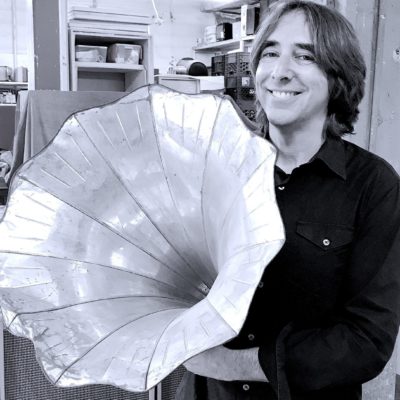Sound Pedagogy – Teaching the Audible Dimensions of Poetry: A Conversation (plus clips and sample syllabus) with Chris Mustazza
September 25, 2020
Jason Camlot
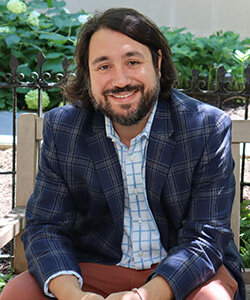

I have known Chris Mustazza as a researcher, expert in the history of speech labs, co-director of the PennSound Archive, experimenter in machine-aided poetry listening, collector and student of old-time audio media technologies, and as a friend, for many years. So, the range of possible topics we might have discussed for this Listening, Sound, Agency Forum interview was vast, to say the least. I might have asked Chris to tell us about the back-end of PennSound, about his DIY approaches to the computational analysis of poetry readings, about any imaginable detail pertaining to the speech lab recordings of philologist and English Professor William Cabell Greet, or about the latest recording device he’s in the process of restoring. But instead we have decided to focus our discussion on questions of pedagogy, and approaches to teaching with sound recordings. When I was visiting Al Filreis and Chris at University of Pennsylvania back in November 2018, I had the opportunity sit in on on one of Chris’s interdisciplinary literature classes, a course called Poetry Audio Lab: Modernism & Sound Studies, and I was amazed at how seamlessly he had woven questions of poetics, performance, media history, and digital approaches to listening and analysis into his syllabus. As one of the early experimenters in teaching poetry through a major audio poetry archive (PennSound), and as a regular collaborator with Al Filreis, another innovator in this area who draws upon the audio archive in his wide-reaching ModPo MOOC, talking to Chris about teaching represents a unique opportunity to think about rationale, methods and effects of teaching poetry with sound. We conducted our discussion by email during the months of July and August 2020.
Welcome to the SPOKENWEBLOG, Chris, and thank you for taking the time to engage in this conversation with me.
Thank you so much for the invitation to do this interview, for the great idea to focus on sound studies pedagogy, and for these generous questions. I’m so thrilled to be discussing this topic with you, as my work and thinking has been very influenced by our conversations over the years.
To start with, can you tell us a bit about yourself, your research, how you came into your present role with PennSound, and how your dissertation project evolved from your experience at U Penn?
Sure! Well, when I came to Penn in 2003 to help Charles Bernstein and Al Filreis launch PennSound, I didn’t have any formal training in poetry. I had just graduated with a degree in Information Science and was about to start my Master’s in Penn’s engineering school in Computer and Information Technology. I configured and build the servers that would host PennSound, developed its audio standards and digitization workflows, and oversaw all of the operations for the project (I was its founding Managing Director). Today we have over 6,000 hours of audio and 60,000 recordings!
I became interested in modern poetry in the course of working on the PennSound recordings, and one day I had the out-there idea to do a Ph.D. in English, all while working full time as IT director at Penn. Thanks to the generous and nurturing environment in Penn’s English department, I was able to do this, completing my doctorate in four years.
I see all of this work as being part of a common project. I’ve always been interested in building things and the process of creation, which for me is what marries poetics and technology. For the longest time, people saw (and still, to some degree, see) the humanities and STEM as at worst opposed and at best obverse, but I’ve always believed they are doing the same things—focusing on mechanics, how things work, and how to engineer the world we want to live in.
My dissertation topic arose from a combination of my situation and serendipity. I was curious what the precursors to PennSound were—what was the earliest attempt to build an archive of poetry recordings and what were the circumstances of that archive. I was surprised to learn that the practice of recording and storing poets’ voices reached back to the very beginning of sound recording (and one could argue before), and even the very definition of what a poetic performance is was historically situated. The serendipitous part of the project was that I happened to come into contact with the first poetry audio archive recorded in America, made in a dialect lab at Columbia University in the 1930s and ‘40s.
It turns out that this completely understudied archive contained the only or earliest recordings of poets like Gertrude Stein, T.S. Eliot, Robert Frost, James Weldon Johnson, Harriet Monroe, and many others. I worked with Columbia to digitize many of the recordings and to add them to PennSound, and my dissertation/current book manuscript ended up being shaped around these recordings. Actually, I think that’s how we first met—one year at the MLA, I heard you speak and reference the collection, and I couldn’t wait to speak with you afterwards to learn more about it from you. I hadn’t encountered (and still have not encountered) anyone else who knew about it, despite its great importance!
Yes, I remember that! Some of the research I did on those recordings (listening to them from tape reels in a listening booth at the Library of Congress, visiting the aluminium transcription discs and getting to see one of the transcription recording machines at the Columbia archives, reading about the history of the lab in departmental folders of the Barnard College Archive), plus, additional information I learned from you, made it into my chapter on “T.S. Eliot’s Recorded Experiments in Modern Verse Speaking” in Phonopoetics: The Making of Early Literary Recordings. But your own approach to these materials has worked to contextualize them in further, fascinating ways.
My current manuscript, titled Speech Labs: Language Experiments, Early Poetry Audio Archives, and the Poetic Record begins from these recordings and expands to tell an untold story of how most poetry audio archives were born in similar linguistic speech labs—it turns out that experimental phonetics and the practice of making sound recordings of poets were separated at birth. In the study I go all the way back to the world’s first sound archive, the Vienna Phonogrammarchiv, and then move toward other early archives, like Les Archives de la Parole in Paris (which contains recordings of Apollinaire and unplayable inscriptions of Ezra Pound reading), to set the context for the Speech Lab Recordings and the Harvard Vocarium. In fact, as I argue, PennSound itself, and lots of the cool digital methods we’re using to study poetry recordings these days, find their roots in these speech labs.
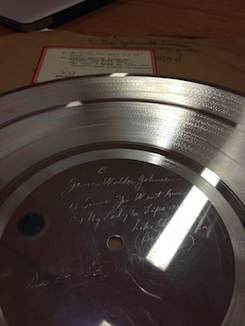
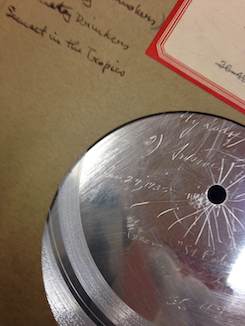
Speech Lab Recordings: Aluminium Transcription Discs of J.W. Johnson Reading at Columbia University, December 24, 1935 (via PennSound)
That’s a rich history to tell. One thing we know about such labs is that they were designed for use not just in research and preservation, but in pedagogy and the development of materials for teaching. Speaking of Pennsound as a contemporary manifestation of this longer history of speech labs, what models of teaching with sound and audio recordings from the PennSound archive have you encountered over the years, and how did some of these influence your own thinking about how to bring sound recordings onto your syllabi and into the classroom?
Well, most of my experiences teaching poetry with sound come from teaching with Charles Bernstein, whose experimental pedagogy extends directly from his poetics and his writing. Recordings of poets are always a primary part of Charles’ syllabi, and teaching with him helped me to formulate a question that animates much of my teaching (and research): What does modernism sound like? I was so taken by hearing the bombastic, political strong-man cadences of Marinetti (not that we need more of that right now—just that I didn’t expect to find it in C20 poetry!), the vacillations between sermonic intonation and vaudeville shtick by T.S. Eliot, and many other examples of poetry not sounding like it’s being read (whatever we might mean by the sound of reading). These experiences led directly into my designing Poetry Audio Lab: Modernism & Sound Studies, the course you visited, which focuses directly on making recordings primary.
That was such an interesting course, and your students were so engaged in the materials and approaches you were teaching. I’m interested to know the longer story behind your development of a course like that. What were some of your first approaches to teaching literature with sound? Can you recall specific examples of what you did, and what the results were from your earliest experiments, that would have led to the eventual development of such a formidable literature and sound studies syllabus?
You know, my teaching was always very aurality/orality-centric even in classes that weren’t specifically about sound, as my current ones are. I always believed that writing should be read aloud whenever possible, in the intonation/voice you think captures its aesthetics. When I taught comics and graphic novels, I’d have students read sections of Watchmen aloud and encourage them to embody what they imagined to be the pitch and intensity dynamics of lines. Believe it or not, I feel the same way about an op-ed from The New York Times—language always has sound and if we read around the sound, looking just for semantic meaning, in a referential sense, we miss most of what is going on. I know that’s probably not how you expected me to answer this—as a sort of paean to old school dramatic speech education—but I think that starting with the basic point that writing has a phonic dimension that is part of its overall meaning is important.
Working specifically with audio recordings of poetry (or other content), I like to start with the intentionally vague question of “what does this sound like?” and “have you heard this kind of voicing or performance elsewhere—commercials, speeches, etc?” Students will usually find a hook into something familiar to them which can lead us into important questions around performance, sonic aesthetics, and the very porous boundary between poetry and other kinds of speech.
I’ll always remember one example when I was playing recordings of F.T. Marinetti, the Italian Futurist, whose poetics I’ve long felt were problematically animated by Mussolini’s radio speeches. None of the students in the class spoke Italian, so they were forced to grapple with just the sound symbolism and speech sounds of Marinetti’s bombastic performance. One student raised his hand and said, jokingly, “I have no idea what that guy is saying…but I agree with him.” While a funny point, there is so much to be learned from it, not the least of which is how much political language is meant to be seductive in its pure form—in many cases we say the sounds of speech extend meaning, but in this case, we might say the sound is meant to distract from the troubling meaning. There is so much focus in the university on learning to interpret writing, while almost none on the affordances of learning to interpret the implications of speech—and the critical failure of not being able to do so.
This is true, even as there has been an explosion of critical work on “listening” as a technique that has developed culturally within the frameworks of a wide range of disciplines, in music studies, of course, but also in science and medicine, media studies, phenomenology, ethnographic studies, linguistics, digital humanities, as well as sound-oriented art practice, and rhetoric, composition, and education studies. Listening is an under-conceptualized cultural technique in literary studies, I think, but there are many approaches from other disciplines to learn from, to correct that “oversight”. I’m interested in hearing more about some of the approaches to listening that you have integrated into your teaching, and we can talk about that some more in a moment, but first, I’d be interested to know how your thinking about teaching with sound recordings has changed over the years.
As you can probably tell from my other answers, I am very interested in provoking questions around where poetry ends and something else begins. So my syllabi increasingly contain more content that does not announce itself as poetry or might not even be recognizable as such. I can almost always draw a reaction at some point in the semester that approximates—“Is this really a poem?” Of course, the idea of “What is a poem?” is an old topic for people who work with experimental works, but I think that the implications from the question are still important. Or I guess a better question for me is: What’s at stake in calling something a poem? What does it do to the value of that writing for you? How does it change what you understand to be its purpose? And, maybe most importantly, how does it change the way you read it and the amount of attention you give to the work’s form? Going back to my previous example, if I gave you an excerpt from an editorial and said that it was a poem, you would just read it differently, trying to extract from it its spoken prosody and maybe even trying to read the speaker as a persona rather than the author as such. So I think that has been one of the biggest changes for me, trying to balance giving the students a solid understanding of C20 poetry while also giving them the tools to speak about aesthetics in the wider world.
Ok, so getting back to the question of how you integrate listening exercises into your teaching, can you share an example of a specific sound recording you have used in the classroom, and how you have used it?
I always find a way to include Kurt Schwitters’ Ursonate alongside Tracie Morris’s “handholding” with Schwitters (her adaptation of the Ursonate). Schwitters’ work is so powerful and haunting precisely because it seems like “nonsense” at first. But the better word is pre-sense. It’s an attempt to capture the emotive and semantic properties of pre-lingual or extra-lexical speech. Even as the sounds attempt to evade traditional semantics, they connote meaning through their pitch, timing, etc. Of course, most students here in the U.S. don’t know German, but if they did, they would hear particles of German words ricocheting around in the performance. That’s where Morris’ virtuosic performance comes in—in her adaptation (translation?) of Schwitters, we can hear echoes of English words. It raises the question of whether it’s possible to invent non-culturally/socially rooted speech and the question of how artistic abstraction works when the medium is sound.
I’m beginning to get a sense of how you are inviting your students to listen to the materials you assign. Can you share an example of an actual exercise about engaging critically with a sound recording that you have assigned to students, and tell us how that went?
Sure! Have you ever heard Cassandra Gillig’s Put Me in Charge of Poetry Magazine? It’s an incredible album where she mashes up recordings of poets with contemporary pop songs. My favorite track on the album is probably Sylvia Plath reading “Daddy” mashed up with Eminem and Rihanna performing “Love the Way You Lie.” I have the students pick a favorite track from the record and write a brief close listening of just the poem, explain what they think the song means, and then describe how the music and poem come together to form something new. The following assignment asks them to make their own remix/mashup using any poem from the syllabus and any song they think brings out the poem’s poetics. So the poem comes first in this case—the choice of music and accompanying explication is meant to demonstrate their understanding of the poetics. Students have done some incredible work with this and some have gone on to make fully wrought music videos as their final projects. For example, inspired by the track above, one student made a music video close reading of the Pub Scene from The Waste Land using a custom montage of videos and Eminem’s “Rap God” beat. Even though that class is over, I still watch her video from time to time because of how perfect it is at exposing the dark social dynamics of that scene.
That’s so great. I had a similar experience with the thoughtfulness and affective power of soundworks that students in a recent Literature and Sound Studies seminar were able to produce. Some of that student-produced sound work was even featured recently in an episode of the SpokenWeb prodcast, called “Ideas have feelings, too.” I have found that asking students not just to listen to sounds, but to work with them and engage in the process of understanding the implications of a sonic (rather than just print-based) rhetoric has been another way of expanding the methodological capacity of students to listen critically and creatively. Your own teaching experiments corroborate this experience, So, thanks for that! Now, another question (I’m trying to learn some of your teaching tricks): What’s your favorite “first sound” to play to students in a class, and why?
So, this is a weird choice, but I usually play a little-known recording of George Broderick performing “The Departure,” an uncollected poem by Eugene Field (digitized by Tim Gracyk here). I like to use this recording for a few reasons. The first is that it’s historically interesting that the first (perhaps) recording made by Victor Records (record A-1) was of a poem. But more importantly, I think the recording stands at a crossroads for both vocal recordings and poetic form. From a poetry standpoint, it ushers out the Victorian ballad culture in anticipation of the first wave of modernism. It’s a great example of what the modernists were reacting against (this kind of poem is exactly the metronome in Pound’s famous dictum “compose in the sequence of the musical phrase, not in the sequence of the metronome”). From a sonic standpoint, the over-articulated, booming elocution of the performer stands out so starkly against our current moment of understated speech in the era of the microphone. I think it provides a great opportunity for students to reflect on why exactly this recording sounds so “old-timey” and why this kind of speech seems so very different from the conversational styles of the current moment.
Yes, this kind of listening raises all kinds of important questions about the historically and culturally-informed nature of sound and speech, and, again, seems to demonstrate how the use of sound can expand our critical reach in teaching literature. So, returning again to the question of methodology in literary studies and pedagogy that came up earlier, can you share a bit more about how you believe teaching-with-sound challenges and expands the critical approaches and methodologies that we use in the literature classroom?
This is a great question, and there are so many ways to go with it. I’m going to pick the one that is usually at the top of mind for me, which is the voices—plural—that are always present in language, regardless of how much it tries to cohere into a unified voice. I explain it to the students like this: do you ever find yourself in a situation where you find that you sound like—I mean actually sound like, like using the same cadences, speech patterns, etc.–your mom or dad when talking? Or, perhaps for a grad student (or even a professor!), do you ever find that you sound like your own academic mentor when giving a paper? I’m very interested in the idea that people perform multiple, interwoven identities through speech, and I think we hear this particularly well in literature because we ask listeners to listen so closely. When discussing a performance, I always ask “What does this sound like to you?,” and it’s interesting when students will compare a literary performance to a commercial or a particular YouTube ad. I think it casts a crucial light on how sonic aesthetics are constantly deployed to influence—at the political level, at the commercial level—and makes clear how important it is to learn to wade through these sonic-semiotic seas.
You could say that we’re still at the beginning of a wave of discovery about how sound can inform our understanding of literary history, and how we can transform our approaches to teaching literature. What are some teaching-with-sound experiments that you would like to try out in future classes?
I’m very interested in exercises that allow students to work with physical audio materials in the library, especially those without much context or provenance information attached to them. I think there is something very generative in advancing one’s knowledge about some mysterious sound recording by touching it, reading any writings on it, playing it on coeval equipment, and finally researching its provenance. That process of knowledge rooted in sensory experience is so crucial to sound and media. I think it was Wolfgang Ernst who said that you need to be a collector-scholar with sound recordings; you have to have a kind of tinkerer-mechanic fascination with the objects themselves. I would really like to do something like this next time I teach with the Kelly Writers House DAT tape archive that was just donated to the Penn Library.
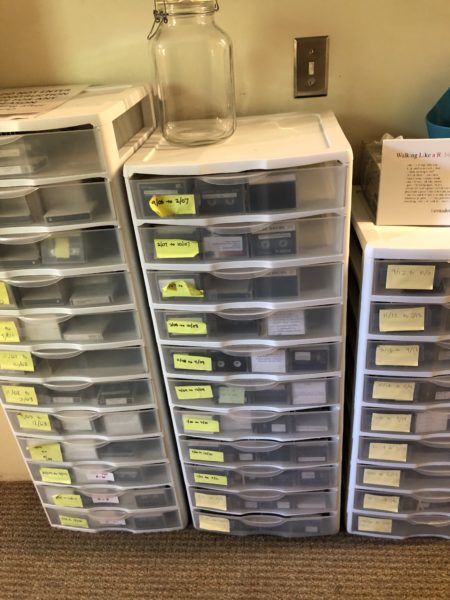
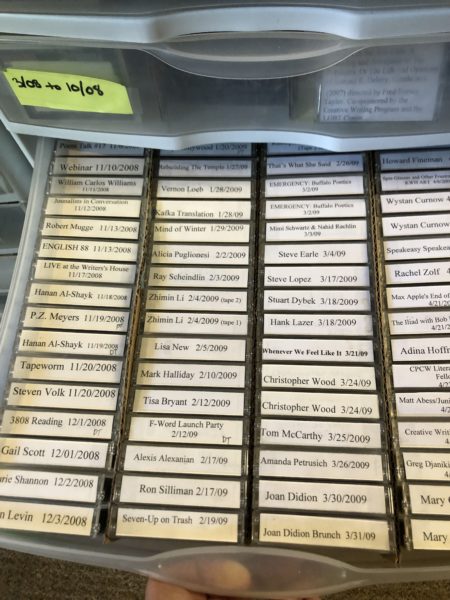
Digital Audio Tape (DAT) collection held at Kelly Writers House, University of Pennsylvania (Image Courtesy of Chris Mustazza)
The students could pick one of the two-thousand or so tapes, write a critical bibliography of it based on the liner notes, and then digitize the tape on a DAT deck at the library before writing about how the physical object can shapes the particular poems recorded on it.
I love this example, and it is a great one to close with, because it points to one of SpokenWeb’s key conceptual and practical preoccupations, namely the relationship between media, (archival) collections, (historical) events, performance, and texts, within the frame of “the literary.” Thanks so much, Chris, for getting to the heart of things by sharing your inspiring ideas about teaching literature with sound.
It has been my pleasure!
Chris Mustazza is Co-Director of the PennSound archive, IT Director at Penn’s School of Arts & Sciences, and teaches in Penn’s English department. His work focuses on the history of sound recordings of poets, as well as experimental digital analyses of speech recordings. Chris’s work has appeared or will appear in boundary 2, Digital Humanities Quarterly, The Chicago Review, and Oral Tradition, among others. His current book manuscript, Speech Labs: Language Experiments, Early Poetry Audio Archives, and the Poetic Record, analyzes the long, intertwined history of poetry recordings and experimental phonetics. He earned his Ph.D. in English and Master’s in Computer and Information Technology at the University of Pennsylvania.
This article is published as part of the Listening, Sound, Agency Forum which presents profiles, interviews, and other materials featuring the research and interests of future participants in the 2021 SpokenWeb symposium. This series of articles provides a space for dialogical and multimedia exchange on topics from the fields of literature and sound studies, and serves as a prelude to the live conference.
